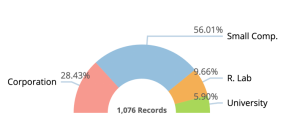3D Printing, Blockchain, or Connected Cars are some of the Automotive Trends that are poised to revolutionize the industry in 2018. These trends will transform how industry players respond to changing consumer behavior, develop partnerships, and drive transformational change.
Much has changed since the first cars were made back in the last years of the XIX century. The automotive industry is distinguished by its capacity for change and is undoubtedly ripe for disruption in 2018.
Digitization, increasing automation, and new business models have revolutionized other industries, and automotive will be no exception. But given the widespread understanding that game-changing disruption is already on the horizon, there is still no integrated perspective on how the industry will look in 10 to 15 years as a result of these changes.
However, 5 main automotive trends are originating the disruption, and identifying them should help industry players better prepare for the uncertainty the potential future states.

1.1. Topic Trends
Connected cars will be able to share information about driving conditions like weather, speed, sudden braking, accidents, and more. It’s the beginning of what is called vehicle-to-vehicle, or V2V, communication, a wi-fi-like technology that will eventually be standard on every new car.
So there’s no wonder why topics like Wireless Communications, Car Sensors, and Vehicle Transmissions are the ones that have grown the most during the last years.

Source: Linkonvate.com
1.2. Connected Cars’ Key Players
Out of the top 10 organizations, 4 are significant carmakers (General Motors, BMW, Toyota, and Audi), and 3 are tech-giant corporations (Samsung, Microsoft, and Google).
Regarding the leading countries, China has a higher position in the ranking than usual. It is the second country worldwide innovating in connected cars. It is worth highlighting the high number of Chinese universities working in the field, almost as many as SMEs.
There’s no wonder why Germany is the European country with the higher number of entities innovating in the field (mainly SMEs), since is one of the countries worldwide with a more prominent tradition in the car manufacturing industry.
As for crucial American SMEs and startups, Airbiquity designs operates and manages telematic connectivity infrastructure. Zubie is a connected-car app that provides location tracking, driver scoring, alert, and location sharing services. And Mojio is an open platform that enables users to connect their cars with other people, places, and things via smartphone apps.
| Name | Score | Pubs. | Confs. | Grants | Patents | TMs | News | Web |
 |
488.4 | – | 6 | 1 | 189 | 2 | 80 | – |
 |
258.8 | – | – | 1 | – | – | 118 | – |
 |
144.8 | – | – | – | – | – | 53 | – |
 |
143.3 | 20 | 24 | – | 44 | 2 | 108 | – |
 |
123.2 | 1 | 8 | 2 | 4 | 11 | 175 | 1 |
 |
104.8 | – | – | – | 2 | – | 142 | – |
 |
100.8 | – | – | – | – | – | 82 | – |
 |
100.1 | – | – | 1 | 8 | 4 | 66 | – |
 |
89.4 | 5 | 3 | – | 27 | 2 | 40 | 1 |
 |
84.9 | 1 | 3 | – | 3 | 1 | 119 | – |
Top 10 Organizations Worldwide Innovating in Connected Cars. Source: Linknovate.com
NOTE: Since we are constantly updating our data, results may vary. Click on the link for more updated results.
1.3. Grants for Connected Cars
Since 2010, there’s been a total of $ 120M of public funding granted to 92 projects for Connected Cars innovation and research.
The University of Southern California is the entity that has received more grants (four in total) for vehicle communications. When it comes to private companies, IBM, Intel, or Siemens are collaborating with smaller enterprises like Autotrip, Lumeova, or SinWaves developing wireless technologies for connecting cars.

Source: Linknovate.com
2.1. Evolution of IoT for the Automotive Industry
Smart IoT is the technology behind major connected cars functionalities, like self-parking and adaptative cruise control, which will be available from virtually every carmaker in new vehicles.
This movement is unstoppable and, while driverless cars themselves won’t populate the road in 2018, the direction seems clear, and so points the data.

Source: Linkovate.com
2.2. Key Players using Smart IoT for the Automotive Industry
Half of the top 10 entities are tech giants such as Microsoft, Google, or IBM. Ford already announced its plan to mass-produce autonomous vehicles by 2021. And Tesla and Google are also making inroads into producing road-legal driverless cars.
A complex ecosystem in which companies are collaborating with each other to develop this technology. For example, Ford is teaming up with Tesla, Audi, the MIT, Volkswagen, BMW, or Volvo. While Google has partnered with BMW, General Motors, Audi, and Volkswagen.
Regarding top SMEs and Startups, Smart Home, Aeris, and Litmus Automation are some of the most exciting projects developing Internet of Things for the Automotive Industry. Most notably, Litmus Automation, which is an end-to-end IoT cloud platform for connecting any type of device to enterprise applications securely.
| Name | Score | Pubs. | Confs. | Grants | Patents | TMs | News | Web |
 |
1856.8 | – | – | 1 | – | – | 182 | – |
 |
1220.3 | 1 | 4 | – | 175 | 7 | 98 | – |
 |
417.5 | – | 5 | 2 | 1 | – | 101 | – |
 |
252.7 | 1 | – | – | – | 1 | 124 | – |
 |
144.8 | 1 | 2 | 1 | – | – | 52 | – |
 |
125.8 | – | 2 | 1 | – | – | 32 | – |
 |
93.8 | – | – | – | – | – | 32 | – |
 |
90.5 | 1 | – | 1 | – | – | 24 | – |
 |
82.6 | – | – | – | – | – | 10 | – |
 |
80.7 | – | – | – | – | – | 10 | – |
Top 10 Organizations Worldwide Innovating in IoT for the Automotive Industry. Source: Linknovate.com
NOTE: Since we are constantly updating our data, results may vary. Click on the link for more updated results.
2.3. Commercial Readiness of IoT for the Automotive Industry
While Connected Cars aren’t a commercial reality yet, the big tech and automotive corporations are in the race for bringing them to the market first. However, we will soon be able to have one of them in our garage, as the market readiness chart (below) confirms.

Source: Linknovate.com
3.1. Entities’ Distribution
Blockchain is one of the automotive trends that is building higher expectations. A super hot technology that is now getting intense attention in the tech space and the first auto suppliers have begun using it in 2017.
As we can see in the chart below, up to 95% of the entities developing Blockchain for the Automotive Industry are private companies (big corporations, SMEs, and startups). We see a higher percentage of corporations than usual, which can be explained given the mass-market potential of the industry.

Source: Linknovate.com
3.2. Top Organizations using Blockchain for the Automotive Industry
In the automotive business, where the supply chain is so essential, blockchain technology can create a trusted, accurate protocol for this supply chain. Removing counterfeit parts from the market should help improve transparency and lead to more efficient pricing strategies.
Microsoft has teamed up with Groupe Renault to deliver a blockchain-based app saving all vehicle information to a streamlined, tamper-proof, and secure digital car maintenance book. While IBM has recently announced a collaboration with Maersk to create an industry-wide global trade digitization solution built on Blockchain to transform global, cross-border supply chains.
But perhaps, the most interesting examples are found within American startups.
CyberCar is a blockchain-optimized connected vehicle platform that offers a software framework, facilitates an immutable ledger, and enables multi-party transactions.
And Movimento is exploring how Blockchain could enable auto manufacturers to track each step of the production and transportation process through a secure database updated by suppliers in real time.
| Name | Score | Pubs. | Confs. | Grants | Patents | TMs | News | Web |
 |
109.6 | – | – | – | – | – | 13 | – |
 |
69.3 | – | – | – | – | – | 19 | – |
 |
24.2 | – | – | – | – | – | 9 | – |
 |
13.9 | – | – | – | – | – | 1 | – |
 |
13.6 | – | – | – | – | – | 3 | – |
 |
13.6 | – | – | – | – | – | 3 | – |
 |
13.6 | – | – | – | – | – | 3 | – |
 |
13.6 | – | – | – | – | – | 6 | – |
 |
11.5 | – | – | – | – | – | 4 | – |
 |
10.6 | – | – | – | – | – | 2 | – |
Top 10 Organizations Worldwide Innovating in Blockchain for the Automotive Industry. Source: Linknovate.com
NOTE: Since we are constantly updating our data, results may vary. Click on the link for more updated results.
3.3. Countries Using Blockchain for the Automotive Industry
It seems Japan is falling behind historical leading car manufacturing countries.
However, European carmakers and Blockchain deliverers are joining forces. Datarella, a German company that delivers Big Data and Blockchain solutions, has partnered with Daimler (German as well). And Swiss cybersecurity and IoT company WISeKey has recently announced that a contract with an unnamed European car manufacturer for the development of connected car technology.

Source: Linknovate.com
4.1. Topic Trends
Big data has been one of the primary game-changers in every industry and is poised to become one of the most promising automotive trends. Predictive analytics uses many techniques from data mining, statistics, modeling, machine learning, and AI to analyze current data to make predictions about the future.
Such intelligent technology will be critical for the automotive industry and the development of connected cars in dealing with Traffic Accidents and Risk Factors.
But predictive analytics will also help costumers, from cheaper insurance for safe drivers to fewer breakdowns. Besides, with potential problems fixed early, vehicles will last longer.

Source: Linknovate.com
4.2. Key Players Using Predictive Analysis for the Automotive Industry
Predictive Analysis is appealing for carmakers to deal with the realities of cost pressures, competition, and volatility. But also materials performance, design, or drivers behavior.
In that sense, giants such as Ford and General Motors are partnering with universities such as Michigan‘s to predict subjective responses from human motion.
IBM‘s presence in the ranking is mainly due to its patent for automating predictive maintenance for automobiles.
As for the academic side, universities such as Queensland or Tongji are focused on assessing car-generated noise and urban pollution.
| Name | Score | Pubs. | Confs. | Grants | Patents | TMs | News | Web |
 |
210.2 | – | – | – | – | – | 21 | – |
 |
14.9 | 7 | 11 | – | 3 | – | – | – |
 |
14.2 | 18 | 4 | 1 | – | – | – | – |
 |
13.3 | – | – | – | – | – | 6 | – |
 |
12.9 | 11 | 5 | – | – | – | – | – |
 |
12.0 | 1 | 1 | – | 1 | – | 4 | – |
 |
10.4 | 11 | – | – | – | – | – | – |
 |
9.5 | 5 | 7 | – | 1 | – | 1 | – |
 |
9.4 | – | – | – | – | – | 1 | – |
 |
8.9 | 13 | 3 | – | – | – | – | – |
Top 10 Organizations Worldwide Innovating in Predictive Analysis for the Automotive Industry. Source: Linknovate.com
NOTE: Since we are constantly updating our data, results may vary. Click on the link for more updated results.
4.3. Commercial Readiness of Predictive Analysis for the Automotive Industry
Companies applying Predictive Analysis to the Automotive Industry are partnering with Universities and Research Labs. The common goal is to achieve real-time insights about customer preferences, so they can adjust production schedules, minimize inventory, and streamline supply chains.

Source: Linknovate.com
5.1. Evolution of 3D Printing for the Automotive Industry
Currently, cars are designed to withstand three, maybe five crashes and last an average of seven to ten years. But 3D printing enables the industry to build a vehicle on a solid chassis with an outer body designed for a single crash. Then cost-effectively replace that while leaving the underlying vehicle structure in place. It could disrupt our concept of accident repair.
When looking at the aggregated set of records Linknovate has collected for 3D Printing for the Automotive Industry, the general trend looks like the sector is skyrocketing.

Source: Linknovate.com
5.2. Key Players using 3D Printing for the Automotive Industry
3D printing will begin to appear in other areas, such as basic car construction done by mainstream carmakers and new players like Local Motors, a low-volume manufacturer of open-source vehicles. After all, 3D printing makes it cost-effective to build things, challenging today’s fundamental approach to car design.
Regarding automotive 3D-printing research, there’s a fascinating ecosystem in which numerous universities are collaborating with each other but haven’t yet started to partner with private companies on a big scale. For example, the University of Texas-El Paso is working with the University of Arizona and with Printed Device Concepts in 3D printed structures with electronics.
As for startups and SMEs entering the sector, Mantis Composites has received an SBIR grant to produce complex 3D-printed carbon fiber parts to be applied in automotive, but also, aerospace and biomedical markets. C-Motive focuses on electrostatic forces. And Juno Racing Cars is investigating how to use 3D Printing to improve the performance of their racing cars.
| Name | Score | Pubs. | Confs. | Grants | Patents | TMs | News | Web |
 |
55.6 | – | – | 2 | – | – | – | – |
 |
33.0 | – | – | 2 | – | – | – | – |
 |
32.7 | – | – | 3 | – | – | – | – |
 |
24.5 | 2 | 1 | – | – | – | – | – |
 |
24.0 | 1 | – | 2 | – | – | – | – |
 |
21.4 | – | – | 3 | 1 | – | – | – |
 |
20.3 | 3 | – | – | – | – | – | – |
 |
17.1 | – | – | 1 | – | – | – | – |
 |
14.8 | – | – | 2 | – | – | – | – |
 |
14.3 | – | – | – | 1 | – | – | – |
Top 10 Organizations Worldwide Innovating 3D Printing for the Automotive Industry. Source: Linknovate.com
NOTE: Since we are constantly updating our data, results may vary. Click on the link for more updated results.
5.3. Grants for 3D Printed Cars
3D-Printed car bodies not only are useful for delivering safety, but also for serving different lifestyles. The same structure remains while the outer chassis can evolve as the driver’s needs and lifestyle change.
Since 2010, there’s been a total of $ 34.25M of public funding granted to 66 different projects for Automotive 3D Printing innovation and research.
Georgia Institute of Technology and the MIT are the entities that have received a higher number of grants (three each). When it comes to private companies, GKN Aerospace is one of the companies that has received more public funding during the recent years.

Source: Linknovate.com










